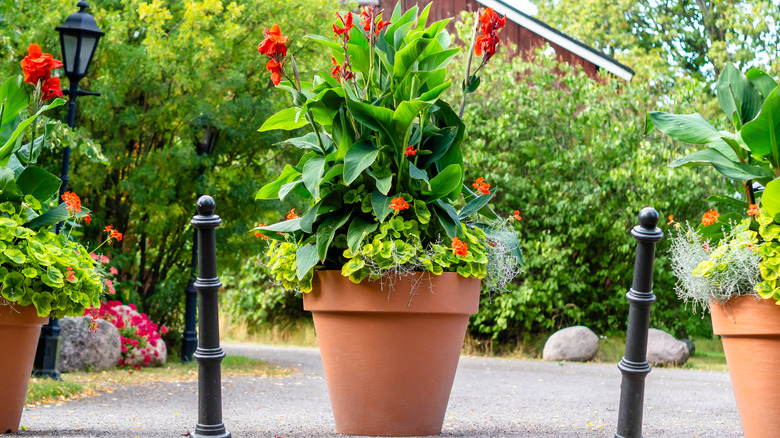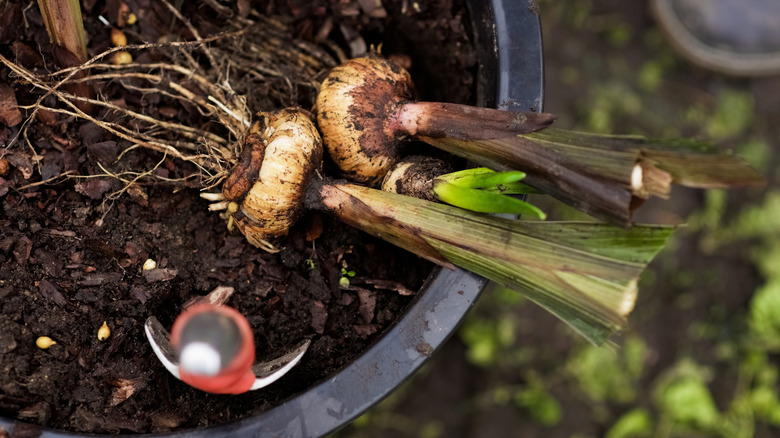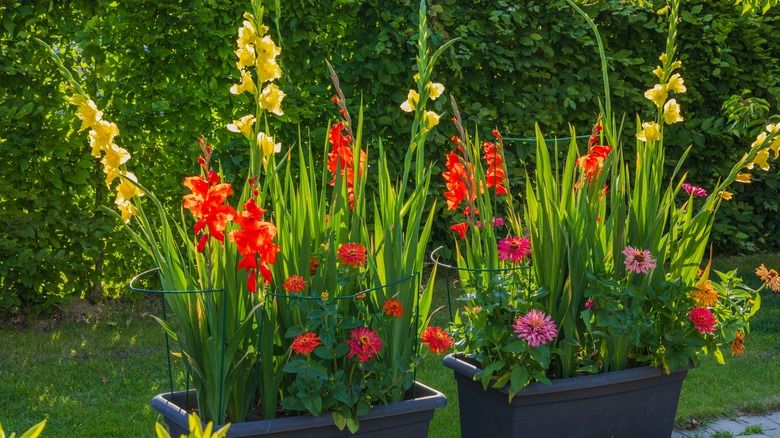How To Plant And Grow Beautiful Gladiolus Bulbs In Containers
The colorful spikes of gladiolus are a garden classic, but you don't need a massive garden to grow these plants — you can just as easily grow them in containers. In fact, even if you do have space elsewhere, you still may want to grow your gladiolus bulbs in containers. Growing your container gladiolus plants isn't a difficult process as long as you meet their need for warmth, light, and water, as well as provide them with stakes or other support. Additionally, it's important to know before planting your gladiolus that hardiness zones are intended for plants growing in the ground, not in containers, so you may not be able to overwinter the bulbs in containers.
Gladiolus (Gladiolus x hortulanus) grows from a type of bulb called a corm, which should be planted after your last frost has passed. Plant the corms about 3 to 6 inches deep, depending on their size, and water them well. While gladiolus can sometimes flower in partial shade, they perform best in full sun and benefit from fertile and well draining soil, so be sure to use a good potting mix in your containers. Gladiolus need regular watering during the growing season, but it's important that you don't overwater the corms before they sprout, as that can easily lead to rot. These conditions should be relatively easy to meet in a container, but if your glads are sharing a pot with over plants, be sure they all thrive in similar conditions.
Staking and storing gladiolus
Once your gladiolus plants have started to grow, you may notice that they require support to keep from falling over. While many gladiolus can grow to 6 feet in height, they aren't heavy plants, so a simple stake of bamboo, or even reusing sunflower stalks, should easily support the plant. If you don't like dealing with staking plants, then you may want to opt for a more compact gladiolus cultivar like Glamini, which only grows to around 2 feet tall and doesn't require staking.
Each gladiolus plant only produces one stalk of flowers, so if you want gladiolus all summer, be sure to plant successions of the flowers every few weeks. While your gladiolus corms can generally be left in the ground after they finish blooming and treated as perennials in zones 7 and up, in colder zones they must either be considered annuals or the corms can be stored over winters and planted back out each spring. If you're growing your gladiolus in containers though, it's important to remember that containers generally don't offer as much protection as in-ground beds. This is because in-ground beds hold onto heat better, giving your perennials protection against cold. A common recommendation is to assume a container garden is two growing zones colder than an in-ground garden in the same location. So, while gladiolus corms are hardy in zone 7 and up in-ground, they may only be hardy in zones 9 and up in a container.
Gladiolus companions in container gardens
Thanks to their height and dramatic shape, gladiolus make natural "thriller" elements if you follow the classic formula for designing a container garden. That means you just need to find good filler and spiller plants to accompany them. Colorful coleus can be a perfect option for filling in space and adding complementary colors to your containers. You can then add in a simple sweet potato vine or other trailing plant that spills out of the container and brings the look together.
Because gladioli are well liked by bees, you can also combine them with other pollinator plants to create a perfect pollinator container garden. While many zinnias are too large to work well as filler elements in containers, the profusion series rarely grows over 14 inches, and like most zinnias, they are a huge hit with butterflies and other pollinators. Using yarrow, or even sweet alyssums, as spillers ties the look together and will complement your glads perfectly. The pollinators are sure to love them as well.



